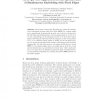154 search results - page 21 / 31 » Where Does Ubiquitous Computing Lead the Organization |
ICDCS
2000
IEEE
14 years 2 days ago
2000
IEEE
Creating replicas of frequently accessed objects across a read-intensive network can result in large bandwidth savings which, in turn, can lead to reduction in user response time....
AMDO
2006
Springer
13 years 11 months ago
2006
Springer
The ability to detect and track human heads and faces in video sequences is useful in a great number of applications, such as human-computer interaction and gesture recognition. Re...
GD
2008
Springer
13 years 8 months ago
2008
Springer
Abstract. We present a linear-time algorithm for solving the simultaneous embedding problem with fixed edges (SEFE) for a planar graph and a pseudoforest (a graph with at most one...
INFOCOM
2010
IEEE
13 years 5 months ago
2010
IEEE
Network coding has been shown to be capable of greatly improving quality of service in P2P live streaming systems (e.g., IPTV). However, network coding is vulnerable to pollution a...
MOBIHOC
2010
ACM
13 years 5 months ago
2010
ACM
In geographic (or geometric) routing, messages are expected to route in a greedy manner: the current node always forwards a message to its neighbor node that is closest to the des...

